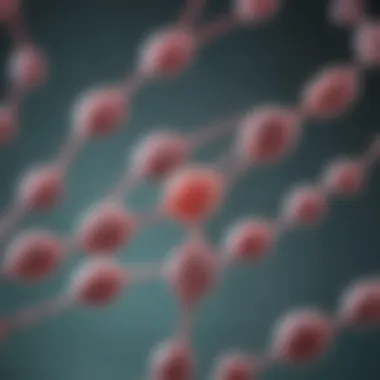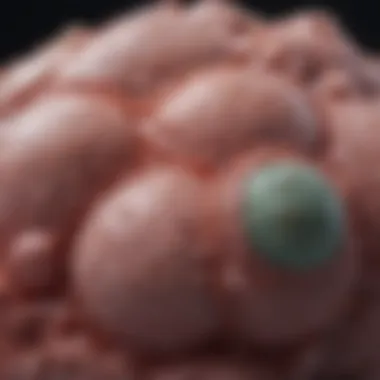Ovarian Cancer in Men: An Unexplored Dimension


Intro
Ovarian cancer is predominantly recognized as a female-specific malignancy, leading to a tangible lack of awareness regarding its occurrence in males. Despite its rarity, the medical community has begun to uncover a broad landscape of consequences stemming from the existence of ovarian-like tissues in male physiology. This raises critical questions surrounding the pathology, diagnosis, and potential treatment of this uncommon cancer type.
This article aims to illuminate the scientific intricacies associated with ovarian cancer presenting in men. By dissecting the underlying biology, genetic components, and clinical implications, we hope to foster a better understanding and awareness of this topic among students, researchers, and healthcare professionals.
Research Background
Overview of the scientific problem addressed
The phenomenon of ovarian cancer in men presents a compelling challenge to the conventional understanding of cancer biology. Historically, ovarian cancer has been associated with women, primarily due to the anatomical presence of ovaries and their definitive roles in reproductive health. Nonetheless, emerging research indicates that men may possess similar embryonic structures, leading to the identification of ovarian-like tissues.
This challenging landscape sparks numerous research inquiries regarding tumor development within these tissues. It is essential to recognize that the molecular mechanisms driving such cancers may not merely mirror those identified in women but could present unique characteristics that warrant specific clinical considerations.
Historical context and previous studies
The historical context of ovarian cancer is deeply rooted in women's health literature. Major studies have consistently highlighted the epidemiology, treatment protocols, and outcomes of female patients. However, male cases have been sporadically documented, often dismissed until the recent advancements that challenge traditional views.
Several publications, including case studies and data analyses, have begun to paint a more complex picture. These works demonstrate instances of men diagnosed with tumors that exhibit ovarian characteristics.
The body of literature remains scant, leaving an apparent gap that necessitates further exploration. By bridging this research gap, healthcare professionals can improve diagnostic accuracy and treatment strategies, which are currently underdeveloped.
Findings and Discussion
Key results of the research
Recent studies highlight a range of clinical presentations and pathways leading to the diagnosis of ovarian cancer in males. Biological research has identified a high rate of mutations in genes such as BRCA1 and BRCA2, which are typically associated with breast and ovarian cancers in women. However, these mutations do not exclusively appear in female patients, and their relevance in male cases is significant.
Moreover, the majority of identified cases emphasize the importance of imaging and biopsy techniques for accurate diagnosis. Notably, males tend to present with more advanced disease at the time of diagnosis. This noted delay often results from a lack of awareness and screening mechanisms tailored explicitly for men.
Interpretation of the findings
The implications of these findings are profound. Understanding the existence of ovarian-like tissues in men redefines how healthcare professionals approach male oncology. This holistic perspective highlights pathways for targeted treatment modalities, which could lead to improved outcomes for patients diagnosed with what is currently considered a rare form of cancer.
To capitalize on the groundbreaking insights from this research, interdisciplinary collaboration among oncologists, geneticists, and radiologists becomes crucial. Such collaboration will foster the development of comprehensive treatment regimens tailored to the unique challenges posed by this condition.
In summary, ovarian cancer in men remains an unexplored and under-recognized dimension of oncology, necessitating heightened awareness and research focus to navigate its complexities effectively.
Foreword to Ovarian Cancer in Men
Ovarian cancer in men represents a complex and largely overlooked area of oncological research. This topic challenges the conventional understanding of cancer biology, expanding our perspectives on male reproductive health. Traditionally, ovarian cancer is associated solely with women due to the presence of ovaries, yet certain clinical observations indicate the possibility of analogous structures and conditions in males.
The importance of highlighting ovarian cancer in men lies in its implications for diagnosis, treatment, and care. Recognizing this rare condition can significantly impact clinical practices. It calls for a reevaluation of disease definitions and strategies applied in oncology. Emphasizing the need for awareness and research will help foster an environment conducive to better understanding this subject.
Moreover, unraveling the biological mechanisms behind the occurrence of ovarian-like tissues in males might lead to advancements in treatment. Such progress could result not only in more effective therapies but also in improved patient care and management strategies. The clinical cases and empirical evidence surrounding this phenomenon are rare, yet they serve as crucial learning points in oncology.
Thus, exploring the intricacies of this topic can pave the way for a more nuanced dialogue among healthcare professionals, researchers, and policymakers, ultimately promoting innovations that could impact a small number of patients but nonetheless hold significant scientific merit.
Theoretical Framework: Male Ovarian-like Structures
Understanding the potential presence of ovarian-like structures in males is crucial in grasping the complexities of ovarian cancer manifesting in such a demographic. This section delves into how biological and anatomical anomalies might predispose men to develop ovarian cancer. Unlike traditional cancer presentations, this rare occurrence emphasizes the importance of recognizing male-specific anatomy's role in cancer conditions typically associated with female physiology. By exploring this framework, one can appreciate the need for tailored diagnostic and therapeutic approaches in oncology.
Embryological Development
During embryonic development, both males and females initially share similar structures including the gonads. As the process progresses, development diverges into male and female pathways. However, certain anomalies can occur, leading to the formation of ovarian-like structures in males. It is important to understand that these abnormal structures may retain some functionality that resembles their female counterparts.


Several conditions can influence this development:
- Disruption in Sexual Differentiation: Genetic mutations or hormonal influences may lead to atypical development.
- Exposure to Environmental Factors: Teratogens or hormonal imbalances during critical periods of development can also contribute to these changes.
Research into these embryological processes can yield valuable insights into how and why males might develop ovarian-like tissues, thus presenting them with similar oncological risks.
Genetic Considerations
Genetics plays a vital role in the understanding of any form of cancer, including ovarian cancer in men. The insights gained from studying genetic predispositions can redefine how researchers and clinicians approach this rare condition. Key factors include:
- Chromosomal Anomalies: Some males may possess chromosomal variations that affect sex differentiation and the development of reproductive structures.
- Mutation of Key Genes: Specific mutations in genes such as the SRY gene can potentially cause ambiguous genitalia or the formation of ovarian-like structures in males.
- Family History of Cancer: Understanding familial cancer syndromes can also influence screening and prevention strategies for groups at risk.
Genetic studies can help establish a clearer picture of how these factors correlate to the incidence of ovarian cancer in men, creating more precise treatment protocols.
By uncovering these embryological and genetic elements, one can cultivate a nuanced comprehension of the biological intricacies enveloping ovarian cancer in males. Further investigative efforts are essential for developing effective strategies in managing this rare but significant health issue.
Clinical Cases and Evidence
The exploration of clinical cases and evidence regarding ovarian cancer in men is essential for several reasons. First, it highlights the rarity of the condition, prompting further academic inquiry and clinical awareness. As a phenomenon that diverges from conventional understandings of cancer, the study of these cases serves to expand the medical community's knowledge base. It opens discussions on the implications for diagnosis, treatment options, and effective management of this unexpected manifestation of cancer.
Evidence drawn from clinical cases can illustrate the spectrum of symptoms and potential outcomes. This helps in guiding future research effectively. By understanding the clinical nuances, specialists can develop tailored treatment regimes for affected individuals. Such insights could ultimately enhance survival rates and quality of life.
Additionally, examining rare case studies allows researchers to identify patterns that might otherwise go unnoticed in larger populations. This can raise questions about genetic predispositions and biological mechanisms that underlie the presence of ovarian-like tissues in men. Understanding these factors can shift perspectives in both clinical practice and academic discourse.
Rare Case Studies
The rarity of documented cases of ovarian cancer in men makes each case study significant. Anecdotal reports, though limited, have given insight into diagnosis and treatment challenges. For instance, a rare case reported a 55-year-old male with a diagnosed germ cell tumor exhibiting ovarian-like characteristics, emphasizing the need for histopathological evaluation.
These rare occurrences can reveal information about the complexities of male anatomy and the conditions under which ovarian cancer may develop. Furthermore, these studies contribute to a growing database of evidence, shifting the perception of what can be included in the differential diagnosis when faced with similar presentations in men.
In one notable case, a male patient presented with abdominal pain and increased levels of alpha-fetoprotein. Subsequent imaging unveiled an unusual mass resembling ovarian tissue, leading clinicians to revise their initial suspicion of testicular cancer. The multidimensional aspects of such case studies prompt critical discussions about the need for comprehensive diagnostic criteria.
Research Insights
Investigations into ovarian cancer in men remain sparse but hold potential for significant discoveries. Recent research has highlighted the role of genetic factors in the development of ovarian-like structures in males.
Studies suggest that mutations in specific genes, such as those involved in the development of gonadal tissues, could play a crucial role. Ongoing studies aim to better characterize these mutations and their implications for cancer pathogenesis in men. Engaging with this body of research can reveal insights into how similar mechanisms may lead to atypical cancer presentations across a spectrum of patients.
"Understanding these emerging complexities can change how we approach cancer diagnosis and treatment in unexpected patient populations."
The pursuit of knowledge in this area may also open doors to novel therapeutic strategies tailored to men with ovarian cancer. Integrated research efforts that focus on both clinical evidence and genetic underpinnings are vital in broadening the landscape of oncological care.
Symptoms and Diagnosis
Understanding the symptoms and diagnostic processes related to ovarian cancer in men is crucial for timely intervention and management. Given the rarity of this condition, awareness of atypical signs is essential. Early detection enhances treatment efficacy and potential survival rates. Therefore, educating healthcare providers and patients about possible indicators is of utmost importance.
Common Symptoms
Although ovarian cancer is primarily recognized as a female disease, men can experience symptoms that may indicate the presence of ovarian-like tumors. Some common symptoms include:
- Abdominal Swelling: This may arise due to the accumulation of fluid or the tumor mass itself. Men might experience discomfort or noticeable bulging in the abdomen.
- Pain in the Pelvic Area: This might be intermittent or constant. Men should note any unusual pelvic pain that persists.
- Changes in Bowel Habits: Symptoms such as constipation or diarrhea can signal gastrointestinal compromise.
- Unexplained Weight Loss: Sudden weight loss can be indicative of multiple health issues, including malignancies.
- Fatigue: Chronic tiredness that is unresponsive to rest may be an early warning sign of an underlying issue.
It is essential for individuals to recognize these symptoms and not dismiss them as trivial. Seeking medical advice promptly can lead to earlier diagnosis and better outcomes.
Diagnostic Procedures
A multi-faceted approach is utilized for diagnosing ovarian cancer in men. Here are key diagnostic procedures:


- Medical History Review: A comprehensive assessment of the patient's medical history helps identify any hereditary links or previous health issues.
- Physical Examination: Clinicians often conduct a thorough examination to check for swelling or abnormalities in the abdominal and pelvic areas.
- Imaging Tests: Techniques such as ultrasound or CT scans can provide visual confirmation of abnormal growths in the reproductive or abdominal regions.
- Blood Tests: Measuring certain tumor markers, such as CA-125, can support diagnosis and help monitor treatment effectiveness.
- Biopsy: In some cases, a biopsy may be required to obtain a definitive diagnosis by examining tissue for cancerous cells.
Each of these procedures plays a vital role in forming an accurate diagnosis. Early diagnosis is critical in managing this condition effectively, ensuring that treatment options can be explored before the disease advances.
"Recognizing symptoms and understanding diagnostic avenues can significantly alter the prognosis of rare conditions like ovarian cancer in men."
With diligence in identification and assessment processes, healthcare providers can better navigate this uncommon yet serious condition, ultimately improving outcomes for individuals diagnosed with ovarian cancer.
Treatment Options and Protocols
The treatment of ovarian cancer in men presents unique challenges and considerations. Given the rarity of its occurrence and the lack of extensive clinical experience, protocols are primarily adapted from female ovarian cancer treatments. Understanding these protocols can significantly influence patient outcomes, offering both the potential for recovery and a framework for ongoing research. Effective treatment strategies must balance aggressiveness with the quality of life, making this an essential area for further exploration.
Surgical Interventions
Surgical intervention is often the first line of treatment for those diagnosed with ovarian-like tumors in men. This procedure typically involves the resection of any tumorous tissues, which may include oophorectomy or removal of adjacent structures depending on the tumor’s location and size. The goal of surgery is twofold: to eliminate as much cancerous tissue as possible and to assess the stage of the disease.
When contemplating surgery, several factors must be taken into account:
- Patient Health: The overall health of the patient influences recovery outcomes and surgical options.
- Tumor Characteristics: Size, location, and whether the tumor has spread dictate the surgical approach.
- Potential Risks: Like any surgery, there are risks involved, including infection and complications related to anesthesia.
Post-operative care is vital for recovery and may include monitoring for complications as well as managing pain effectively.
Chemotherapeutic Approaches
Chemotherapy is another cornerstone of treatment for advanced cases. It is often used after surgery to target residual cancer cells. The choice of chemotherapeutic agents can differ from those used in women. Commonly, drugs such as cisplatin and paclitaxel have shown effectiveness in treating ovarian cancer, although data in men remains limited.
Key considerations in chemotherapy include:
- Regimen Selection: Determining the most effective regimen based on tumor pathology and response.
- Side Effects Management: Common side effects such as nausea, fatigue, and immunosuppression must be managed thoughtfully.
- Monitoring: Regular assessments help track the effectiveness of the treatment and adjust plans accordingly.
Innovative Therapies
Research into innovative therapies is crucial in developing future treatment protocols for ovarian cancer in men. Several novel approaches are currently in focus:
- Targeted Therapy: This involves using medications that specifically target cancer cell abnormalities, potentially reducing harm to normal cells.
- Immunotherapy: Leveraging the body’s immune system to fight cancer may offer new hope. Agents that help activate immune responses against tumors are being studied.
- Genetic Profiling: Understanding genetic factors in individual tumors can lead to personalized treatment strategies, improving efficacy and reducing unnecessary side effects.
These therapies show promise but require extensive clinical trials to establish their safety and effectiveness.
Important consideration: Ongoing research and clinical trials are essential for advancing treatment options, improving patient outcomes, and refining protocols specific to male presentations of ovarian cancer.
Epidemiology and Incidence
Epidemiology and incidence of ovarian cancer in men represent an essential aspect of understanding this rare condition. By examining how frequently this disease occurs and identifying its potential risk factors, one can gain insight into not only its biological underpinnings but also its impact on public health. This information can guide researchers and healthcare professionals in developing strategies for early diagnosis and effective treatment.
Statistics and Data
The incidence of ovarian cancer in men is not well-documented, largely due to its rarity. Most data stem from isolated clinical cases rather than large-scale studies. For instance, reports indicate that cases may be exceedingly low, possibly fewer than 1% of all diagnosed cases of ovarian cancer. Understanding these statistics aids in quantifying the burden of the disease in a male population.
Moreover, gaining access to registries and databases can provide better insights into age distribution, survival rates, and geographical trends. Collecting data on male-specific ovarian cancer cases can enhance clinical knowledge and foster more targeted research efforts.
Risk Factors
Identifying risk factors for male ovarian cancer is complex, due to limited evidence. However, several hypotheses arise based on existing understanding of similar cancers. Factors may include:
- Genetic Predisposition: Similar to women, men with mutations in BRCA1 or BRCA2 genes may have an elevated risk.
- Hormonal Factors: The role of hormonal influences in male physiology remains under-researched concerning ovarian-like structures.
- Age: Like many cancers, the probability of developing ovarian cancer increases with advancing age.
Each of these factors contributes to the overall risk profile and understanding of disease mechanisms. Active monitoring and more extensive research into these areas are paramount. Recognizing the interplay among these elements offers a pathway to comprehending and potentially mitigating the risks associated with this rare condition.


Psychosocial Aspects
Understanding the psychosocial aspects related to ovarian cancer in men is crucial for comprehensive healthcare management. This dimension explores the emotional, social, and psychological factors affecting individuals diagnosed with this rare condition. The importance of these aspects can't be overstated. Psychological well-being can significantly influence treatment outcomes and overall quality of life for patients. Attention to psychosocial elements can facilitate better coping strategies and enhance support mechanisms for both patients and their families.
Impact on Mental Health
The diagnosis of any cancer invariably induces significant psychological and emotional stress. For men facing ovarian cancer, these effects can be profound. The unusual nature of this diagnosis may lead to confusion, fear, and anxiety. Changes in self-identity, masculinity, and societal roles can cause additional mental distress.
Research indicates that cancer patients often experience higher rates of depression and anxiety compared to the general population. Specific factors influencing mental health in these cases include:
- Fear of mortality: The fear of death is a common concern among cancer patients, and men may struggle with accepting an unfamiliar diagnosis.
- Stigma: Given that ovarian cancer is less recognized in men, there may be feelings of isolation or shame, complicating emotional responses.
- Physical changes: Treatment options may result in significant bodily changes, affecting self-esteem and body image.
It is essential to address these mental health issues through regular psychological assessments, interventions, and supportive therapies. Professional help should not be overlooked as it plays a vital role in enhancing coping mechanisms.
Support Systems
Robust support systems are vital for men diagnosed with ovarian cancer. Various mechanisms can offer essential emotional and practical help. Support can come from family, friends, healthcare providers, or support groups.
- Family and Friends: Close relationships often provide the first line of support. Open communication about feelings and experiences is beneficial for everyone involved. Family members may also need guidance on how to assist their loved ones effectively.
- Healthcare Providers: Doctors and nurses can offer psychological support during treatment, but they should also recommend mental health specialists when needed. The healthcare team should prioritize communication and empathetic care to help mitigate feelings of isolation.
- Support Groups: Connecting with other men who have similar experiences can normalize feelings of fear and anxiety. Sharing stories and coping strategies can foster a sense of community. Online platforms, such as forums on Reddit, can be valuable resources where patients can connect anonymously.
Incorporating these support systems can greatly enhance the emotional resilience of patients, enabling them to navigate the complexities of diagnosis and treatment more effectively.
"Understanding and addressing the psychosocial dimensions of ovarian cancer in men is not merely beneficial; it is essential for optimal outcomes for both mental health and overall quality of life."
Future Directions in Research
Research into ovarian cancer in men is still in its infancy, yet this phenomenon holds great potential for significant scientific breakthroughs. Understanding the presence of ovarian-like structures in male anatomy can unlock new avenues for diagnosis and treatment. The rare presentation of this cancer opens up a dialogue that could reshape our comprehension of male-specific cancers.
Current knowledge is limited. Future research can enhance the field of oncology by addressing critical gaps related to male patients. Investigating the biological mechanisms at play can offer insights that have been overlooked. One of the main benefits of this research trajectory is the ability to identify effective treatment protocols. If the underlying biology of this cancer type is understood better, tailored therapies could be developed, improving patient outcomes.
Emerging Studies
Recent studies have started to explore the genetic and molecular basis of ovarian cancer-like presentations in men. For example, the focus has shifted towards investigating mutations in specific genes known to influence ovarian development. In particular, research into the SRY and DAX1 genes proves crucial as their interactions may contribute to the abnormal development of ovarian-like tissues in males.
Moreover, ongoing clinical trials aim to assess the efficacy of medications traditionally used in female ovarian cancer on male patients. Analyzing data from these trials will provide valuable information on clinical responses.
- Understanding Biological Markers: Future studies are looking to identify biological markers specific to ovarian cancer in men. These markers could lead to earlier diagnoses and more personalized treatment plans.
- Genetic Screening: Emerging studies may advocate for genetic screening in families with history of ovarian cancer. This can help better assess risks in male members.
Potential Discoveries
As researchers delve deeper into this unexplored area, several significant discoveries may arise. One potential outcome is the identification of male-specific treatment protocols that could differ substantially from those used in female patients. Exploring gene therapy tailored to males may create more effective intervention strategies.
Another possibility is the discovery of unexpected linkages between male ovarian-like tumors and other health conditions. For instance, further exploration may reveal correlations with hormonal imbalances or chronic diseases, providing a broader context for understanding the implications of this cancer.
It is critical to encourage funding and institutional support for comprehensive studies, as investment in this niche can yield groundbreaking advancements.
The evolving landscape of oncology necessitates that researchers remain vigilant and proactive in their pursuit of knowledge. The potential discoveries from investigating ovarian cancer in men might not only enhance our understanding of this rare condition but can also inform about broader oncological trends, ultimately advancing treatment options for all cancer patients.
Culmination
The discussion surrounding ovarian cancer in men holds significant importance within the realms of medical research and oncological treatment. While traditionally linked to women, the recognition of male cases invites a broader understanding of cancer biology. This article illuminates the previously shadowed aspect of ovarian-like tissues in males and the nuances it presents for diagnosis and treatment. By considering these atypical presentations, healthcare professionals can enhance their clinical approach, improving outcomes for affected individuals.
Summary of Findings
This investigation into ovarian cancer in men reveals several crucial insights:
- Rare Presentation: Cases of ovarian cancer in males are exceedingly rare, but their existence raises questions about male anatomy's potential for ovarian-like tissue.
- Clinical Relevance: Understanding symptoms such as abdominal pain and swelling can lead to timely diagnosis, which is often overlooked due to the uncommon nature of this cancer.
- Research Gaps: Current literature is scant, indicating a pressing need for further scholarly inquiry to elucidate the complexities surrounding male ovarian cancer.
Call to Action for Research
The findings suggest an urgent call for more focused research on this critical topic. Investigators should aim to:
- Explore Genetic Links: Research should delve into the genetic predispositions that could lead to the development of this cancer in males.
- Support Clinical Studies: Encourage participation in clinical trials aimed at establishing effective treatment protocols specific to male ovarian cancer.
- Increase Awareness: Professional bodies must emphasize the need for awareness regarding symptoms and risk factors, especially among healthcare providers.







